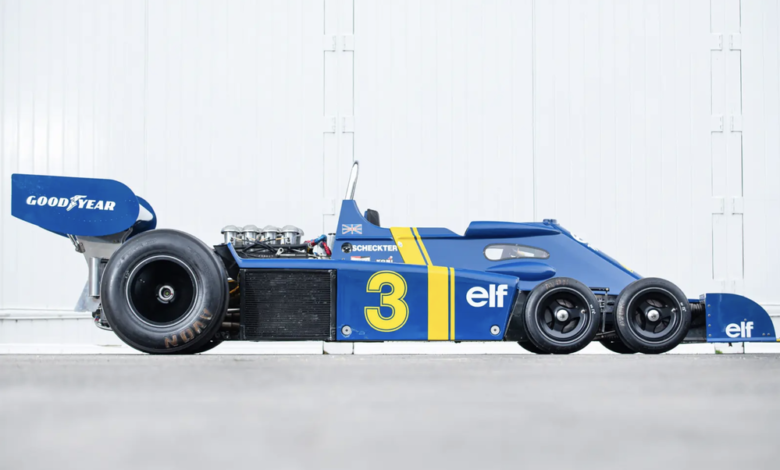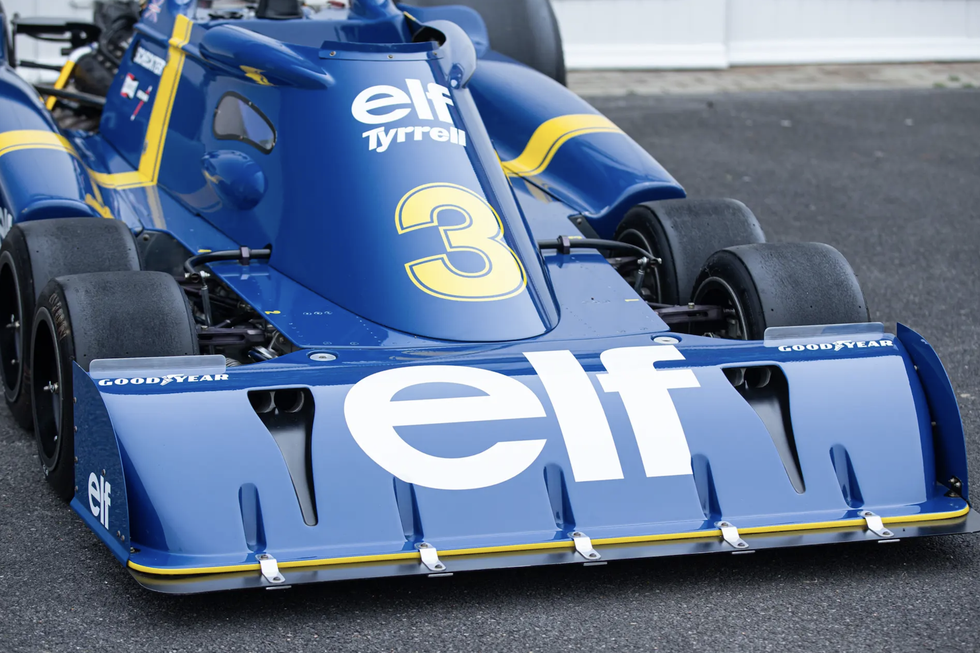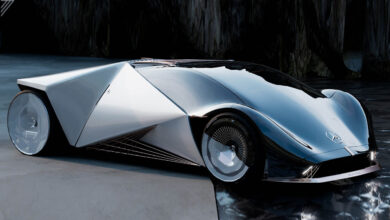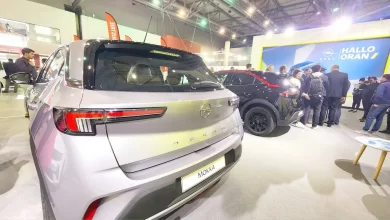Wild Six-Wheel Tyrrell P34 Formula 1 Race Car up for Auction

- The only six-wheeled car to enter an F1 race, the Tyrrell P34 was as successful as it was odd.
- Winning first and second place at the 1977 Grand Prix in Sweden was a highlight for this instantly recognizable machine.
- This example is up for auction in Monaco and has previously won its series at the Monterey Historic Automobile Races.
What has six wheels and wins F1 races? No, it’s not Lando Norris going on holiday with his McLaren pulling a tent trailer. It’s the Tyrrell P34 Formula 1 racecar from the late 1970s, bizarre in appearance but successful in competition. Not only is the P34 the only six-wheeled F1 car to actually compete, but at the 1977 Swedish Grand Prix, two P34s finished first and second in a resounding proof of concept.
This 1977 Tyrrell P34 was built from chassis number eight, constructed in period and kept by the racing team as a spare. During the mid-1990s the project was started to bring it to full racing specification, and it debuted at the Monterey Historics in 2008, where it promptly won the 1970s F1 racing series. Bought by F1 ace Jody Scheckter, who won that Swedish Grand Prix in a P34, it’s now up for auction in Monaco by RM Sotheby’s.
The Tyrrell Backstory
Tyrrell as an F1 team was born in a woodshed. Ken Tyrrell was an RAF serviceman during World War II and a timber merchant afterward. He got as far as Formula 2 as a racing driver and then settled into a team management role, with the cars stored at a workshop at the family timber business. He was also instrumental in uncovering some hidden talents. Ken Tyrrell was first to put Jackie Stewart in a Formula Junior racing seat, and it was racing for Tyrrell that Stewart would win all three of his F1 world championships.
That success was down to another bright British man of the shed-tinkerer variety. Derek Gardner was working on four-wheel-drive systems in the late 1960s when he was approached by Tyrrell to build a racing chassis. He did so in his garage, and while this first effort was slightly brittle, the later 003 model proved its mettle with Stewart at the wheel.
Gardner was known for his inventive engineering, and he was looking for an edge. At the time, F1 had become something of a level playing field, with nearly every constructor using Cosworth V-8s, Hewland gearboxes, and Goodyear tires. Gardner’s genius stroke was figuring out that nobody said how big or how many of those tires were to be used.
Using a concept he’d first thought about as an IndyCar application, he designed a six-wheeled racer with four steerable wheels up front, small enough to tuck inside the bodywork. With this more slippery profile and less lift from an exposed pair of front tires, he was able to reduce the amount of downforce required up front, and thus also reduce drag. By Gardner’s calculation, it was the equivalent of an extra 40 horsepower—enough of an advantage to win.
Dubbed Project 34 (hence, P34), the car was developed in total secrecy. Not even the drivers were told, and the Goodyear engineers who created those tiny 10-inch tires up front kept their lips zipped. When noted racing journalist Denis Jenkins was invited by Tyrrell to come have a look at the P34, he was completely bowled over.
“I got on my motorcycle and rode over to Ken’s house in West Clandon, and after a welcoming cup of coffee he said: ‘Come out into the garden,'” he wrote in his book Jenks: A Passion for Motorsport. “Totally unprepared for what to expect, I followed him out to the lawn and my mouth fell open, and a look of total disbelief came upon my face. Ken roared with laughter as I stood there speechless.”
Tyrrell debuted the P34 at the 1976 Spanish Grand Prix to a mostly flummoxed audience. French racing driver Patrick Depailler raced the sole P34 chassis, while teammate Scheckter drove a more conventional Tyrrell 007. Scheckter qualified 14th. Depailler put the P34 on third.
After that ’77 one-two punch in Sweden, the P34 experiment faded to an end. Part of the problem was tire development, as Goodyear obviously developed its mainstream F1 tires for multiple teams, but didn’t want to spend the R&D money on the oddball 10-inch tires.
Still, the P34 was victorious and remains so today, and it’s also one of the most interesting and innovative machines to line up on a F1 grid, let alone put its driver on the top steps of the podium. Putting this race-ready example in your garage is a chance to own a piece of F1 history. The auction is this Saturday, May 11.
Brendan McAleer is a freelance writer and photographer based in North Vancouver, B.C., Canada. He grew up splitting his knuckles on British automobiles, came of age in the golden era of Japanese sport-compact performance, and began writing about cars and people in 2008. His particular interest is the intersection between humanity and machinery, whether it is the racing career of Walter Cronkite or Japanese animator Hayao Miyazaki’s half-century obsession with the Citroën 2CV. He has taught both of his young daughters how to shift a manual transmission and is grateful for the excuse they provide to be perpetually buying Hot Wheels.




